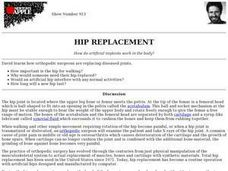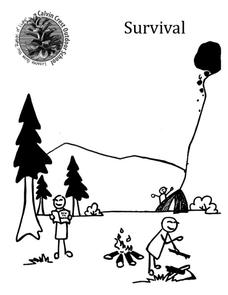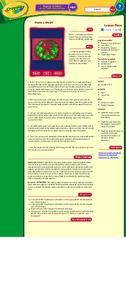Curated OER
How Do Airplanes Stay off the Ground?
Students use balloons and string to duplicate Bernoulli's Principle of wing shape and its affect on liftoff.
Curated OER
Hip Replacement
Students take a close examine animals' skeletons to see how their pelvis and femur work together for movement. By investigating their skeletons students discover the placement and functions of our own bodies. They use owl pellets in this...
Busch Gardens
Create an Invertebrate
What better way for young biologists to learn about invertebrates than by creating their very own? Here, students are assigned a set of invertebrate characteristics and are asked to invent an imaginary ocean animal...
Biology Junction
Dissection of the Clam
Is the structure of a clam really as simple as it seems? Young scholars explore the anatomy of the clam in an engaging lesson presentation. The lesson highlights the digestive process of the clam as well as how it moves and what it does...
Curated OER
Personal Power Figures
Students create African Personal Power Figure boxes describing how they view themselves and discuss what personal traits are important to the preservation and improvement of a civilization.
Curated OER
Paper Folding to Make Cubes
Examine patterns of figures composed of six-squares and predict which of the twenty presented could be folded to make a cube. They then fold large-scale patterns of these figures to confirm their hunches.
Curated OER
Short 'e'
First graders recognize the short vowel e in written and spoken language. Through matching activities, they discriminate the short vowel /e/ from other phonemes. Students associate the phoneme with its letter representation and identify...
Curated OER
Hop on Pop - Short 'o'
Students practice the alphabetic significance of the letter /o/ along with its awareness of phonemes in spoken words. They assess on construction paper the phrase, "We like to hop on top of Pop who's on top of a hot rock" written on it...
Curated OER
Monster Symmetry
Third graders understand what a line of symmetry is and how to draw symmetrically. In this monster symmetry lesson, 3rd graders create an original monster that is symmetrical. Students participate in additional symmetry activities.
Calvin Crest Outdoor School
Survival
Equip young campers with important survival knowledge with a set of engaging lessons. Teammates work together to complete three outdoor activities, which include building a shelter, starting a campfire, and finding directions in the...
DiscoverE
Sun-Warmed Treats
Treat your class to a fun activity, complete with treats. Groups create a solar oven from a pizza box. They then use it to heat up some food ... that's what an oven is for, after all!
Exploratorium
Seeing Your Blind Spot
Viewers use a small, dimmed flashlight to identify the blind spot for both the right and left eye. It is a simple activity to incorporate into your activities during a lesson on vision and the structure and function of the eyeball.
Urbana School District
Fluids
In 1879, Sir William Crookes discovered the fourth state of matter, plasma. The presentation covers states of matter, phase changes, density, pressure Pascal's Principle, buoyant force, Archimedes' Principle, Bernoulli's Principle,...
Curated OER
Weave a Wreath
Students follow directions to complete a multi-step process that results in an attractive holiday decoration. In this Christmas art activity lesson, students employ simple measuring and weaving techniques and experiment with the negative...
Curated OER
Teaching About Plate Tectonics and Faulting Using Foam Models
Young scientists learn about plate tectonics and the three different types of faults (normal, reverse, and strike-slip) using foam models. The activity also covers common types of locations where these faults are found.
Curated OER
Feudal Powers in Japan
A traditional textbook chapter focuses on feudal powers in Japan, and includes vocabulary, note-taking tips in the sidebar, main ideas, and follow-up assessment questions. It also incorporates opportunities for art...
Curated OER
Lesson: Paul Chan: "Score for the 7th Light"
Music, art, and poetry coalesce in a single exhibition, and in a single lesson. Critical thinkers analyze the Fluxus art movement as it's seen in the work of Paul Chan's 7 Lights. They consider the use of poetry and music in his...
Curated OER
ASL: Lesson 20
Teach it, learn it, communicate with it. ASL is at your fingertips with this sign language series. Lesson 20 focuses on classifiers, descriptive vocabulary, and asking questions. Each blue link on the page takes you to an image or video...
School Improvement in Maryland
Smart Growth
New roads, new businesses, new developments, new mass transit systems. All growth has both positive and negative effects on communities. Government classes investigate the principles of Maryland's 1997 Smart Growth program and...
DLTK
Peeping Groundhog Puppet
Using paper and a pencil, produce a pop-up puppet of a groundhog that peers out and over it's burrow to tell us when Spring is coming.
Curated OER
Paper Bag Puppets
Students create "paper bag puppets" using basic art supplies, construction paper, and their imagination in this awesome early-elementary Art activity. The lesson includes a resource link and suggests teaching a short history of puppetry...
Curated OER
Digital Scavenger Hunt
Students participate in a game of scavenger hunt. In this teamwork lesson, students use clues to find hidden objects. Students must work cooperatively to complete each task.
Curated OER
Storybook Theater
Tell a story visually using this resource. Learners design a storybook theater by creating a book and painting watercolor pictures describing scenes from the story. This is a creative means to have your class practice summarizing skills.
Curated OER
Go Fish
Here is a good art lesson on creating colorful versions of fish. After studying images of a variety of fish, young artists choose one that they want to create an image of. Using some high-quality materials, they create their masterpieces...























